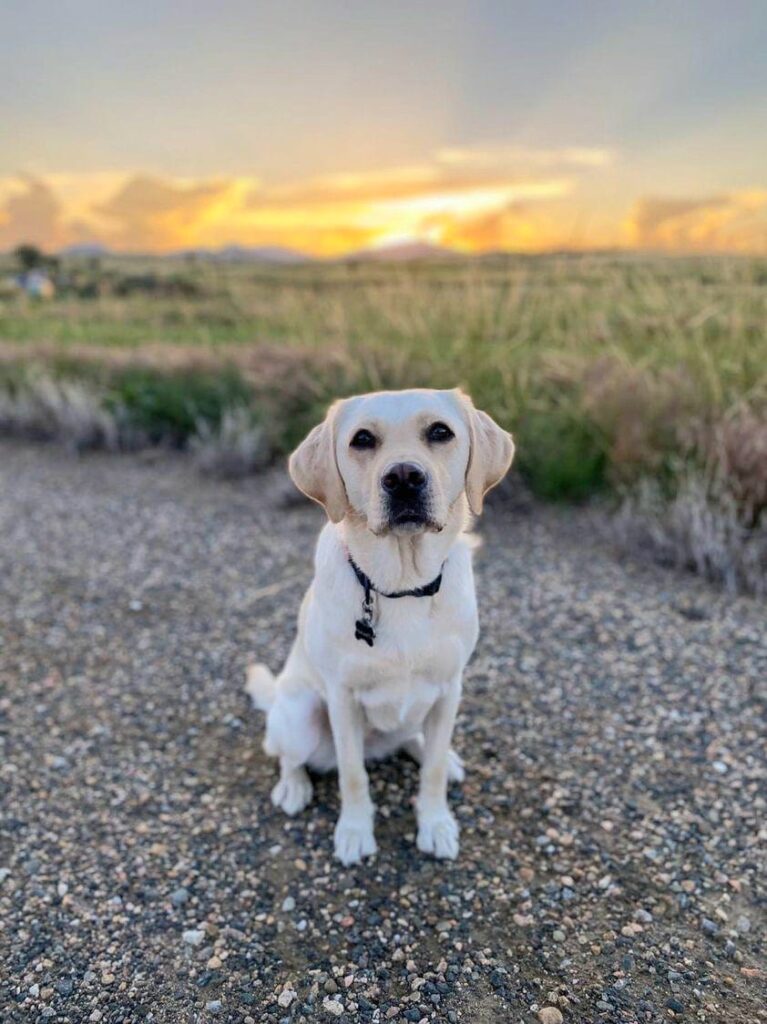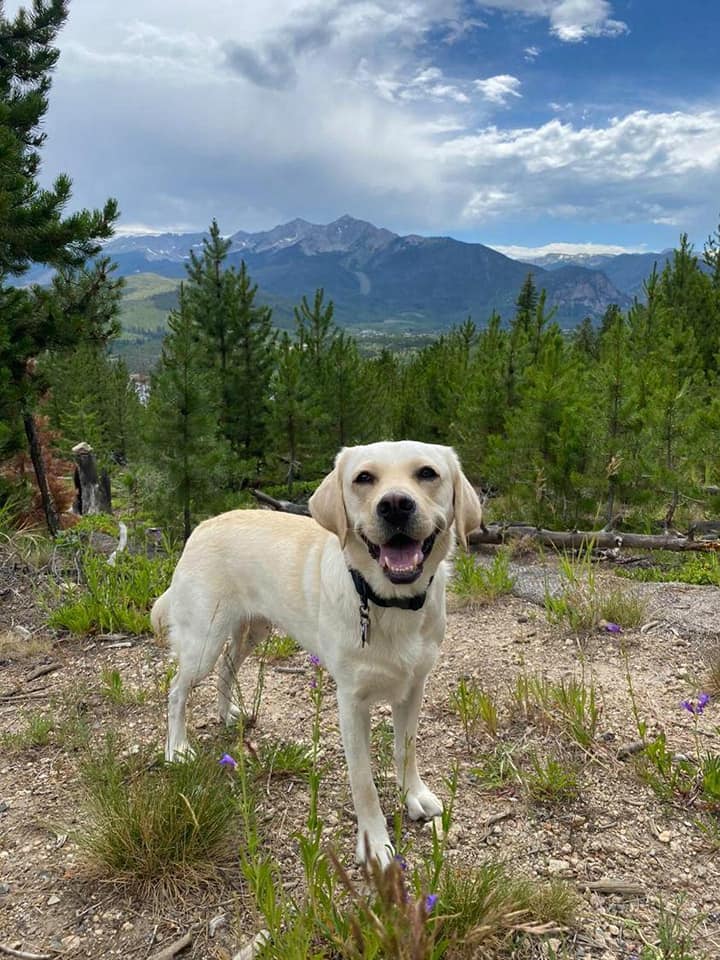Volunteers are the driving force behind Human-Animal Bond in Colorado – HABIC in CSU’s School of Social Work. They’re not in it for the accolades but for the simple joy of bringing comfort to those who need it. After her dog Havarti needed to be ‘career changed’ from being a service dog, Nancy Loos knew volunteering in their local school would make a difference, both for this sweet Labrador who loves to work, and for the students who benefit from animal-assisted therapy with Havarti. They’re turning compassion into action, one paw at a time.
In this Q&A, learn more about Nancy’s experience with HABIC and how she turned a setback into an opportunity to make a positive impact.

Tell us about Havarti’s history. How did she come to be part of your life?
Havarti was our pandemic project. My children, who were in high school and middle school during lockdowns, did what most kids their age did: stayed in bed with no purpose or reason to get up. I couldn’t tell if they were just bored or depressed. We had two senior dogs with mobility issues at the time, which meant they weren’t very active, and adopting a new, permanent family member dog seemed unfair to our dogs.
A friend, knowing I’m a dog lover, forwarded me a link to watch a puppy cam from a service dog organization in Maryland to pass the time, and it led me to research and learn more about service dogs. It seemed like the perfect solution: if we’re struggling, then people who need service dogs must be struggling too, if not worse. We can raise a puppy, be their temporary home to get us moving, give us a purpose, while helping someone in need while we wait for things to reopen.

Who would’ve thought potty training a puppy would be a respite from the loneliness and isolation? Havarti and her littermates were born December 18, 2020, and aptly named after a holiday charcuterie board by the service dog organization. We were assigned to be her puppy raisers and brought her home in April of 2021. My daughter, Sydney, a high school sophomore at the time, agreed to be her full time puppy raiser, with me as the adult supervisor.
In retrospect, Sydney might have bitten off more than she could chew, because soon after we brought Havarti home, she got sick with GI issues at all hours. Sydney would be up all night cleaning up after Havarti, tending to her needs. She got a crash course in what it’s like to be a parent, and developed so much empathy for a puppy she knew wasn’t hers to keep.
When school reopened, we worked with the school district guidance counselor to allow Sydney to take Havarti to classes. At the school, Sydney and Havarti created awareness for invisible and visible disabilities. They also taught others the need for, and etiquette around, service dogs. Sydney brought Havarti with her everywhere, exposing her to as much of the human world as possible to prepare her for service dog training. Havarti loved it. She lived for her work.

Eventually, despite trying numerous treatments, Havarti’s GI issues were diagnosed as food allergies and she was career changed by the service dog organization. We were offered the opportunity to adopt her and there was no way we could say no. After adopting Havarti, I threw myself into researching canine allergies. I stumbled upon a video on the topic by CSU College of Veterinary Medicine’s Dr. Jennifer Schissler, which helped me work with our vet to find a solution for Havarti. Now we seem to have Havarti’s allergies under control *knock on wood* and she lives a very normal, healthy, and happy life. We also use her story and challenges with allergies to help students relate to her, develop empathy, and feel empowered to persevere and overcome challenges.
What attracted you to volunteering in animal therapy?
I’ve always enjoyed volunteering and encouraged it with my children. I’d heard about animal therapy before but didn’t know how to get involved and never looked into it because none of my previous dogs, though amazing and invaluable members of our family, were suitable for therapy work. When Havarti was career changed, she no longer had public access. [Under the Americans with Disabilities Act, service animals may accompany their handlers in public places.] Sydney could no longer take her to school.
So here I am, home with this amazing dog who was bred to serve, and loved to work. What do I do with her? How do I fulfill her needs? We hiked, swam, did food puzzles, and explored every pet-friendly public area in Denver and surrounding suburbs to visit. I even enrolled us in a scent class, which research has shown to be an ageless activity guaranteed to stimulate the dog’s body and mind. There was still a void. Havarti didn’t understand why she couldn’t work anymore, and it wasn’t fair to relegate her to the couch. Luckily, someone I follow on Instagram raises puppies for Guide Dogs for the Blind, and adopted two career changers. She posted about starting the therapy dog certification process with one of her dogs, so I messaged her for more info.

Why did you choose HABIC?
I chose HABIC because of the opportunity to work in school settings. Havarti grew up in a school. The chaos, sounds, smells, hustle and bustle of students, passing periods, bells, classrooms…it’s her jam. In researching different types of animal therapy, I knew any setting where Havarti can actively participate with a human is one she would enjoy and thrive in.

A school setting most resembles her service dog training background, where she tends to focus on one assigned person at a time, ready to be asked to work. And I had volunteered in my children’s elementary school and really missed it ever since they went onto middle and high school where the environment is more independent. It just seemed like the perfect fit for both Havarti and me.
Do you have any training tips for others who want to complete HABIC certification?
Try to always end on a high note. At the end of your training sessions, especially the challenging ones, go back to basics, to things you and your dog are very comfortable and familiar with like, “sit” or “stay.” This will help you both build confidence, feel good about training, and focus on the wins.
What have you enjoyed doing most as a therapy dog team volunteer?
I thoroughly enjoy making a positive impact in someone’s day while spending time with my best friend. Life can be pretty tough. Sometimes, it seems the bad days outnumber the good days, but when I’m on a therapy visit with Havarti, we’re surrounded by smiles, so it perks me up too when I’m having a ‘meh’ day. Smiles are infectious!
What motivates you to stay involved with HABIC?
Experiencing the difference Havarti makes with the students not only motivates us, but makes us a better person, dog, and team. There was one student who struggled with attendance. The goal was just to get him to school. Once he met and started working with Havarti, his attendance improved, at least on the days he knew we’d be there!
After one session, Havarti snoozed while I chatted with the teacher when we heard a faint knock on the door. The teacher cracked the door open to see who was there and I see an arm wielding a piece of paper stick through the door. A student finished his homework and came to turn it in early in hopes the teacher would let him see Havarti. When we agreed, he came in with the biggest smile ever, threw himself on the floor next to Havarti and rubbed her belly.
We often have teachers ducking into our classroom for respite when they know it’s the time and day Havarti is there. They are happy just to sit on the floor and breathe, see her, and pet her if she’s not working with a student. That feeling is euphoric!

In your opinion, what is the most important work HABIC does?
Education. I think education is such a huge deal, because everything involved in the human-animal bond falls under education. HABIC’s dedication to training and education enables all involved to bring awareness to the benefits of therapy animals. I love the support for both clients and the human-animal volunteer teams.

As a human-animal team, I so appreciate the support HABIC provides in continued learning opportunities, responsiveness to emails, easy access and updated training and learning materials, understanding of the human-animal bond, and the challenges teams experience and helping us get through them. And the variety of therapy settings. Havarti and I love the school setting where she can be more interactive with people vs. the “pet me” type settings.
I also love that HABIC understands and advocates for the animals in the program. When I first applied to be part of HABIC, I recall reading something asking what my animal and I did for fun/exercise. I thought, “Wow, that’s awesome! They care about fulfilling the needs of the whole dog, including their mental and physical well-being.” When the new canine respiratory illness got more dangerous this past fall, HABIC was among the first to take action to protect our dogs, and in a non-scary way. It’s all part of the education HABIC provides, and I love that.
About Human-Animal Bond in Colorado
Founded in 1993, Human-Animal Bond in Colorado (HABIC) is a center in the School of Social Work, part of CSU’s College of Health and Human Sciences. HABIC’s mission is to improve the quality of life for people of all ages through the therapeutic benefits of companion animals, with particular focus in the areas of community outreach, teaching, and research.
